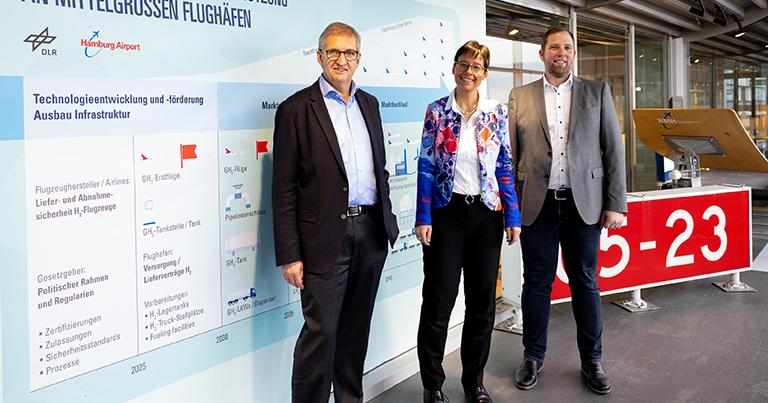
Hamburg Airport and the German Aerospace Center (DLR) have presented a roadmap that sets out the steps required to develop hydrogen infrastructure at medium-sized airports. The roadmap uses Hamburg Airport as an example to outline the growing demand for hydrogen, the development of storage capacities and delivery routes. At the same time, it also highlights the requirements for setting the political course for an energy transition in aviation.
Hamburg Airport could play a pioneering role among German airports in the future. It benefits from its connections to the North Sea, Baltic Sea, and the port of Hamburg. In addition, its route network focused on short and medium-haul flights is a favourable factor for the introduction of hydrogen. Also, the airport is already focusing on transitioning ground services and flight operations to hydrogen.
“We want the energy transition in aviation,” said Michael Eggenschwiler, Chair of the Executive Board, Hamburg Airport. “There is no way around hydrogen. For this reason, we are already involved in several projects that will make a significant contribution to the switch to this clean energy source. If we want to enable the use of this new technology, we need to ensure that the infrastructure is developed and ready for use when the first aircraft take off. This requires not only the willingness of the airport and the aircraft developers, but also of politicians – this is the only way we can set the necessary course together today.”
The topics covered by the roadmap that has been presented range from the expected demand for hydrogen, the design of the hydrogen supply system and the costs that can be expected from today’s perspective to practical aspects such as the adaptation of the airport infrastructure and operational changes to airport processes.
“Networked mobility for liveable places is an important guiding principle for DLR,” said Prof. Meike Jipp, DLR Divisional Board Member for Energy and Transport. “We take challenges in the context of climate change, the energy transition and the transformation of mobility as an opportunity to develop solutions for both urban areas and the surrounding regions. We are developing ideas for vehicle and mobility concepts together with partners from industry, local authorities and transport companies. Airports are important hubs that can make a significant contribution to transforming the transport system and creating liveable places.”
The first short-haul flights using hydrogen propulsion will be possible as early as the next decade, and the industry is planning to introduce hydrogen aircraft for medium-haul flights before 2040. By 2050, the proportion of departures with hydrogen aircraft in Hamburg could rise to 60%. This corresponds to an annual hydrogen requirement at Hamburg Airport of 60,000 tonnes, with a correspondingly significant reduction in CO2.
“The supply and storage of the amount of hydrogen required in the future will require a completely new infrastructure at our airport,” said Jan Eike Blohme-Hardegen, Head of the Environment Department, Hamburg Airport. “We need to start preparing and building this infrastructure now if we want to establish climate-friendly propulsion systems for air transport in the near future.”






